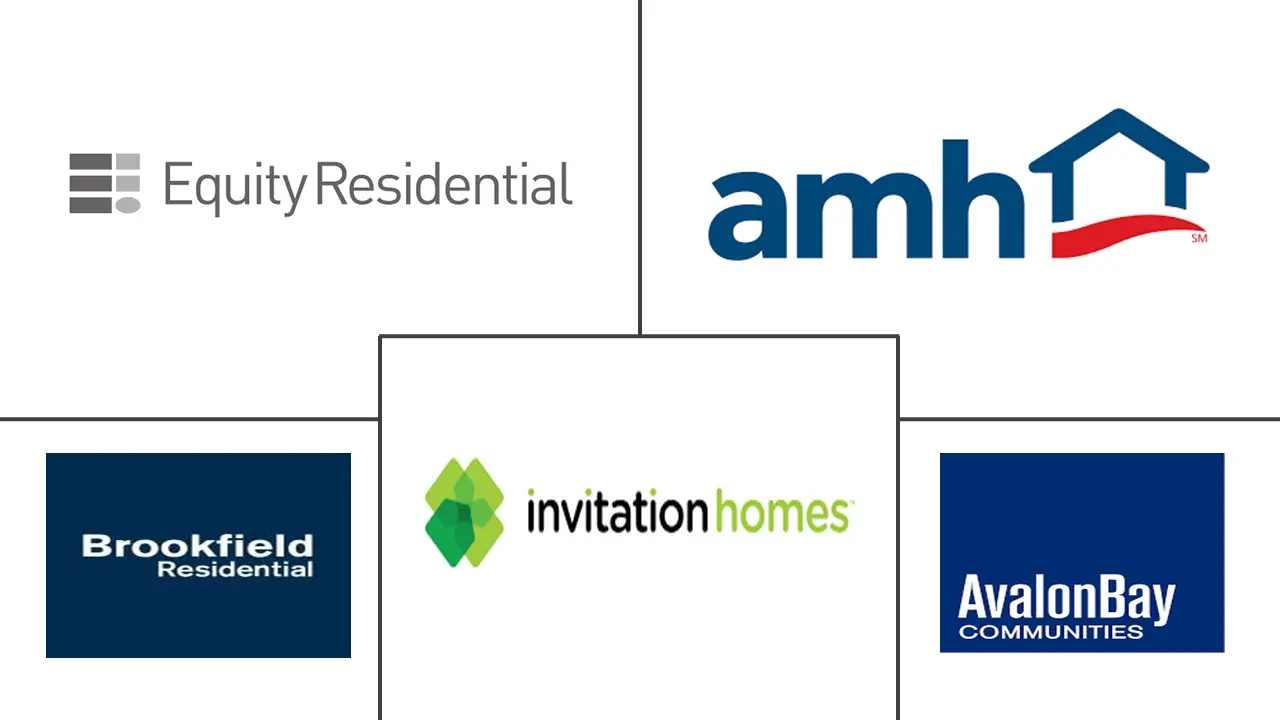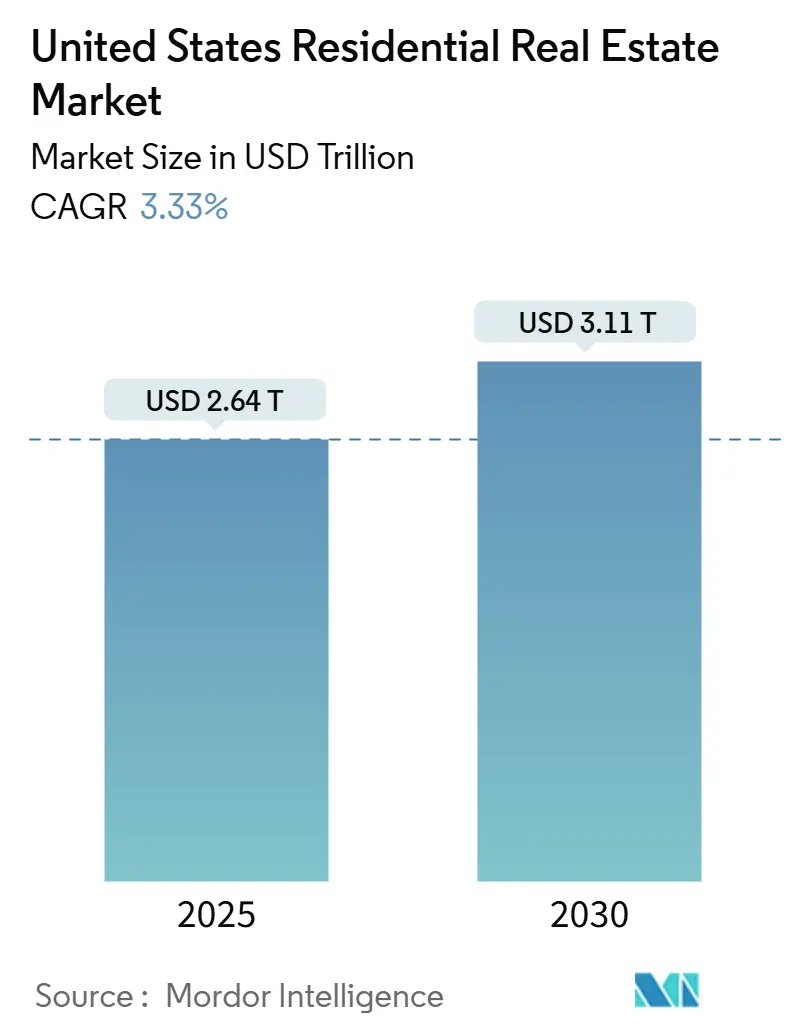
United States Residential Real Estate Market Analysis by Mordor Intelligence
The United States Residential Real Estate Market size is estimated at USD 2.64 trillion in 2025, and is expected to reach USD 3.11 trillion by 2030, at a CAGR of 3.33% during the forecast period (2025-2030).
Growth appears modest, yet it masks decisive structural changes such as the surge of institutional capital, the build-to-rent boom in Sunbelt states, and a demographic wave of millennial buyers who are overcoming past affordability barriers. Regional divergence is a defining feature: the South commands the largest share, while the West posts the fastest growth, driven by technology-led job creation, extreme supply shortages, and persistent remote-work migration flows. Institutional investors—led by Blackstone, Invitation Homes, and other REITs—continue to scale portfolios, accelerating professional management standards and deepening liquidity across asset classes. At the same time, federal energy-efficiency incentives, advanced property-management tools, and fractional-ownership platforms are re-shaping demand patterns and opening new entry points for retail investors. Countervailing headwinds remain, particularly mortgage-rate volatility, construction-labor shortages, and fast-rising insurance premiums in climate-risk zones, creating a bifurcated market in which affordable and luxury segments move in opposite directions.
Key Report Takeaways
- By property type, apartments and condominiums held 81% revenue share of the United States residential real estate market in 2024. The market for single-family build-to-rent projects is propelling the segment toward a 2.10% CAGR between 2025-2030.
- By business model, the sales channel still accounted for 78% of the United States residential real estate market share in 2024. The market for the rental channel is projected to expand at a 2.26% CAGR between 2025-2030.
- By price band, mid-market homes controlled 48% of the United States residential real estate market size in 2024. The United States residential real estate market for the affordable tier is forecast to grow at a 2.18% CAGR between 2025-2030.
- By mode of sale, primary sales dominated with an 88% share of the United States residential real estate market in 2024. The United States residential real estate market for new construction is advancing faster, posting a 2.30% CAGR between 2025-2030.
- By region, the South captured 40% of the United States residential real estate market share in 2024. The market for the West is set to register a 2.40% CAGR between 2025-2030.
United States Residential Real Estate Market Trends and Insights
Drivers Impact Analysis
| Driver | (~) % Impact on CAGR Forecast | Geographic Relevance | Impact Timeline |
|---|---|---|---|
| Accelerated build-to-rent single-family demand | +0.65% | Sunbelt states (TX, FL, AZ, GA, NC) | Medium term (2-4 years) |
| Surge in remote-work migration to second-tier metros | +0.55% | Nationwide, strongest in Southeast & Mountain West | Medium term (2-4 years) |
| Institutional capital inflow via residential REITs & PE funds | +0.45% | National, with concentration in Sunbelt markets | Medium term (2-4 years) |
| Demographic tailwinds from millennials entering prime buying years | +0.40% | National, concentrated in affordable high-growth metros | Long term (≥ 4 years) |
| Federal incentives for net-zero & energy-efficient homes | +0.35% | National, higher impact in states offering additional local incentives | Long term (≥ 4 years) |
| Technology-enabled sales channels (iBuying, fractional ownership) | +0.25% | Initially urban and tech-forward markets, expanding nationwide | Medium term (2-4 years) |
| Source: Mordor Intelligence | |||
Accelerated Build-to-Rent Single-Family Demand in Sunbelt States
Single-family build-to-rent (BTR) deliveries tripled from 2019 to 2023, surging 307% as developers raced to meet demand in Texas, Florida, Arizona, Georgia, and North Carolina. A record 27,495 BTR homes were completed in 2023, up 75% year on year, with an additional pipeline of 45,400 units slated for delivery between 2024 and 2026. American Homes 4 Rent recently surpassed 10,000 purpose-built homes and disclosed another 10,000 in planning, underscoring the institutional confidence in the model. Phoenix, Dallas, and Atlanta have become focal points for BTR communities, reflecting shifting consumer preferences toward single-family living without ownership burdens. The segment is expected to remain a principal growth engine through 2030 as affordability constraints and lifestyle flexibility reinforce tenant demand.
Surge in Remote-Work-Driven Migration to Second-Tier Metros
Remote work accounted for roughly 28% of paid workdays in early 2024, enabling households to decouple employment from housing location and relocate to more affordable cities. Small towns under 250,000 residents attracted 291,400 new inhabitants in 2023, surpassing large-city inflows for the first time since the 1970s. Relocating workers saved between USD 1,200 and USD 12,000 in annual housing costs and often purchased homes priced USD 7,500 below those in their origin cities. Charlotte, Raleigh, and Orlando emerge as beneficiaries, combining job creation with lower costs. The migration trend is structurally expanding the United States residential real estate market by redirecting capital and labor to second-tier metros poised for sustained demand.
Institutional Capital Inflow via Residential REITs & PE Funds
Blackstone’s USD 3.5 billion purchase of Tricon Residential in January 2024 added 37,478 homes and created the third-largest single-family portfolio in the country. The firm followed up with a USD 10 billion acquisition of Apartment Income REIT (AIR Communities) in April 2024. Invitation Homes targets an additional USD 600 million–1 billion in acquisitions during 2025 after expanding its managed portfolio to nearly 110,000 homes through ventures with Quarterra Group and Centerbridge Partners. These deals underscore a liquidity wave that standardizes professional management, deepens secondary-market exit options, and channels unprecedented scale into the United States residential real estate market.
Federal Incentives for Net-Zero & Energy-Efficient Homes
The Inflation Reduction Act enhanced the Section 45L tax credit to USD 2,500 for Energy Star homes and USD 5,000 for Zero Energy Ready Homes acquired through 2032[1]U.S. Green Building Council, “IRA Section 45L Tax Credit Summary,” usgbc.org. Homeowners can claim a 30% Energy Efficient Home Improvement Credit (Section 25C) and a 30% Residential Clean Energy Credit for renewable installations, with no aggregate cap[2]Internal Revenue Service, “Energy Efficient Home Improvement Credit FAQs,” irs.gov. Starting in 2025, products must carry unique IRS manufacturer IDs, creating a formal marketplace for high-performance equipment. These incentives add momentum to green construction and retrofit demand, supporting future growth in the United States residential real estate market as energy costs rise and consumer awareness increases.
Restraints Impact Analysis
| Restraint | (~) % Impact on CAGR Forecast | Geographic Relevance | Impact Timeline |
|---|---|---|---|
| Rising insurance premiums in climate-risk zones | -0.85% | Coastal states and wildfire-prone regions (FL, CA, LA, TX) | Long term (≥ 4 years) |
| Mortgage-rate volatility dampening affordability | -0.75% | Nationwide, most acute in high-cost metros | Short term (≤ 2 years) |
| Construction-labor shortages & escalating material costs | -0.65% | National, with heightened impact in fast-growing markets | Medium term (2-4 years) |
| Local zoning restrictions limiting new supply | -0.55% | Coastal metros and established suburbs with restrictive zoning | Long term (≥ 4 years) |
| Source: Mordor Intelligence | |||
Mortgage-Rate Volatility Dampening Affordability
Average 30-year fixed mortgage rates hovered near 6.93% in January 2025, a level that widened the gap between historic and prevailing rates, locking many owners into existing loans. Freddie Mac calculated the monetary value of this lock-in at USD 47,800 for the typical conventional borrower in late 2024. Inventory scarcity stemming from the lock-in feeds upward price pressure, even as first-time buyers’ share fell to 24% in 2024, the lowest since 1981. Forecasts suggest rates may drift to 6.5% by Q4 2025, yet they remain far above sub-4% levels from 2021, signaling ongoing friction that tempers activity in the United States residential real estate market.
Restraint – Rising Insurance Premiums in Climate-Risk Zones
Homeowners' insurance premiums jumped 21% in 2023, propelled by climate-related catastrophe losses. Florida’s average premium now exceeds USD 11,000 a year, following a 42% surge in 2023, and several national carriers have withdrawn coverage entirely. California faces similar stress as State Farm and Allstate halted new policies due to wildfire exposure, driving families toward state-backed last-resort plans, whose enrollment doubled between 2019 and 2023. Elevated insurance costs diminish purchasing power and complicate mortgage underwriting, weighing on demand in climate-sensitive areas within the United States residential real estate market.
Segment Analysis
By Property Type: Apartments Command Market Leadership amid Affordability Pressures
Apartments and condominiums accounted for 81% of the United States residential real estate market in 2024, outpacing villas and landed houses, and are set to grow at a 2.10% CAGR through 2030. Institutions accelerated multifamily supply as Blackstone acquired AIR Communities for USD 10 billion, reinforcing confidence in stabilized rental income. Build-to-rent momentum further expands the rental pool, with 27,495 dedicated BTR units delivered in 2023. The United States residential real estate market size for apartments is therefore poised to widen as household formation shifts toward flexible, amenity-rich communities.
Villas and landed houses represent 19% of inventory yet confront climate insurance and affordability headwinds, especially in high-risk coastal counties where premiums spike. Demand persists in luxury enclaves with robust wealth inflows, but new supply remains constrained by land scarcity and zoning. Institutional entry into purpose-built single-family rentals is bridging the gap, offering detached living without ownership hurdles and further diversifying the United States residential real estate market.
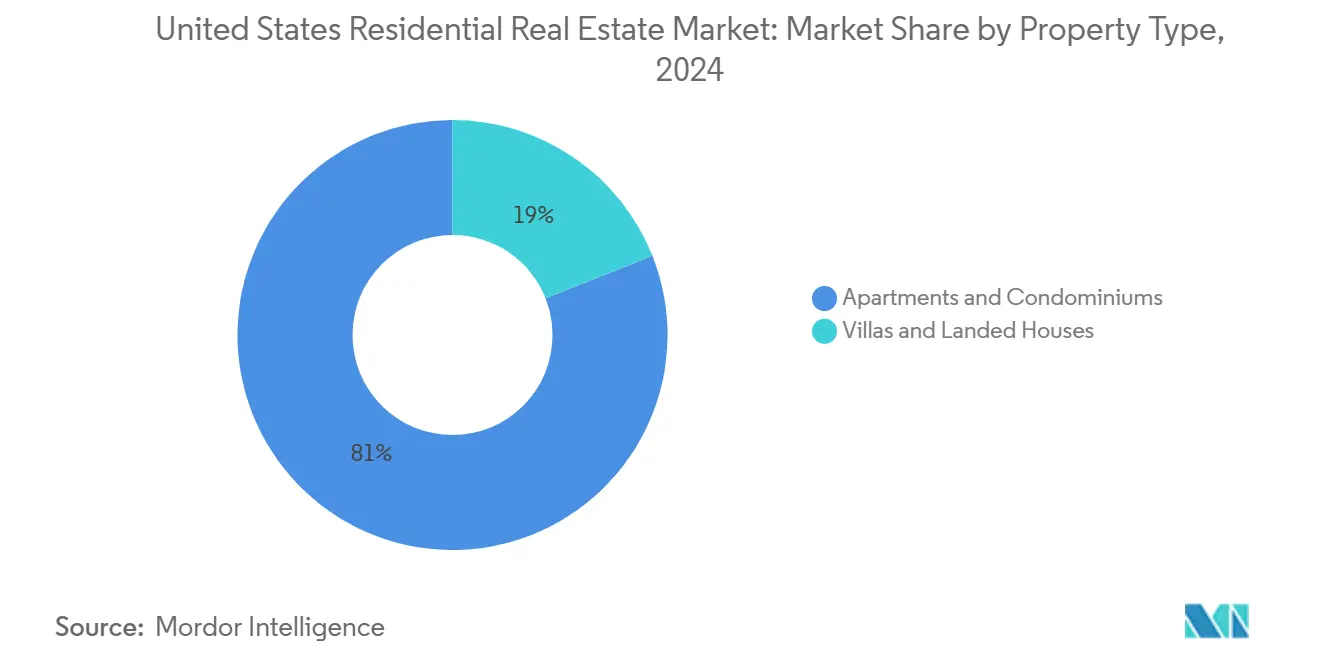
Note: Segment shares of all individual segments available upon report purchase
By Business Model: Rental Growth Outpaces Sales as Ownership Barriers Rise
The sales channel held 78% of the United States residential real estate market share in 2024, though rental revenue is expanding at a 2.26% CAGR through 2030 as mortgages stay elevated. Invitation Homes alone earmarked USD 600 million to USD 1 billion in acquisitions for 2025. Institutional financing capacity and professional management enhance tenant experiences, reinforcing demand for leased housing.
Owner-occupier transactions still dominate the United States residential real estate market size; however, the lock-in effect and tighter credit standards push more households to rent longer. Demographic trends amplify this shift as millennials seek optionality before committing to ownership, suggesting the rental share will rise gradually yet persistently.
By Price Band: Affordable Tier Registers Fastest Expansion
Mid-market homes made up 48% of overall spend in 2024, but the affordable tier is expected to grow 2.18% annually to 2030 as builders pivot toward entry-level product lines. PulteGroup and peers are shortening floorplans and leveraging federal energy credits to hit target price points, broadening the buyer base. The United States residential real estate market size for entry-level stock therefore enlarges in response to stretched affordability metrics.
The luxury segment trails behind in high-risk zones where insurance and climate exposures inflate carrying costs. Nonetheless, premium projects in lower-risk inland metros continue to see steady absorption, underpinned by wealth accumulation and constrained new supply, preserving a dual-track dynamic within the United States residential real estate market.
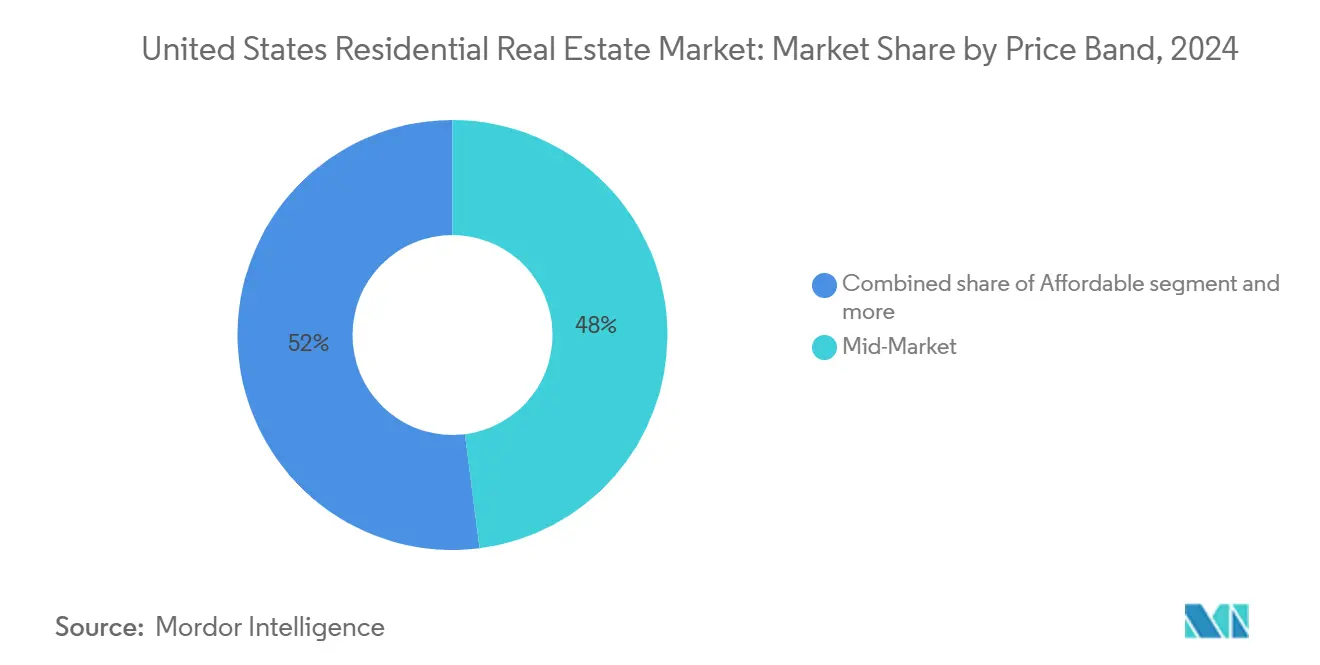
Note: Segment shares of all individual segments available upon report purchase
By Mode of Sale: New Construction Gains Momentum in a Constrained Resale Environment
Existing-home resales delivered 88% of turnover in 2024. Yet new-build volume is projected to compound at 2.30% annually through 2030, aided by lower competition from aging inventory and builders’ ability to offer rate-buy-down incentives. Record labor shortages—501,000 workers in 2024 and another 454,000 in 2025—limit absolute output but do not derail growth potential[3]Associated Builders and Contractors, “Construction Workforce Shortage Analysis,” abc.org.
The United States residential real estate market share for primary sales should therefore rise slightly as production hurdles ease via prefabrication, AI-enabled scheduling, and streamlined approvals in reform-oriented jurisdictions. The emerging equilibrium supports healthier pipeline visibility for builders and diversifies acquisition channels for renters and buyers alike.
Geography Analysis
The Southeast US retained 40% of the United States residential real estate market in 2024, benefiting from pro-business tax regimes, relative affordability, and sustained inflows of corporate relocations. Insurance shocks pose challenges, yet institutional investors remain active, attracted by robust household formation and job growth in Texas and Florida. The build-to-rent rollout underpins further expansion as developers capitalize on accommodative zoning and large land parcels.
The West leads growth with a 2.40% projected CAGR through 2030. Severe housing undersupply, concentrated tech employment, and limited developable land fuel price resilience. California’s zoning reforms have yet to unlock large-scale production, while wildfire-related insurance withdrawals compound scarcity. Market momentum nevertheless persists in Reno, Salt Lake City, and Denver, where in-migration from expensive coastal counties sustains demand.
The Northeast remains a premium market anchored by strong incomes and constrained supply. Massachusetts and New York recorded the highest millennial share of home-purchase loans at 64.2% and 63.8%, respectively. Meanwhile, the Midwest attracts remote workers with affordability advantages and improving employment bases. Small towns gained 291,400 residents in 2023, reflecting a renaissance in markets such as Grand Rapids and Indianapolis. The geographic mosaic highlights the nuanced opportunities and risks embedded in the United States residential real estate market.
Competitive Landscape
Consolidation is reshaping competition across the United States residential real estate market. Blackstone’s 2024–2025 transactions added nearly 100,000 multifamily and single-family units, giving the firm a multi-segment footprint spanning Atlanta, Dallas, and Charlotte. Invitation Homes remains the largest single-family landlord with 80,000 owned homes and another 30,000 under management through joint ventures.
Technology players are likewise scaling. Rocket Companies merged with Mr. Cooper for USD 9.4 billion after acquiring Redfin, consolidating mortgage servicing for one in six U.S. loans. CoStar Group’s USD 1.6 billion purchase of Matterport adds 3D twin capabilities that lengthen online engagement by 20% and enhance leasing conversion.
Despite high-profile deals, institutional ownership remains near 1% of the 82-million-home single-family stock. Competitive intensity is therefore expected to rise as scale providers seek operating leverage through technology and as smaller investors consolidate to withstand financing and insurance shocks in the United States residential real estate market.
United States Residential Real Estate Industry Leaders
-
Invitation Homes Inc.
-
Equity Residential
-
AvalonBay Communities Inc.
-
American Homes 4 Rent
-
Brookfield Residential Properties Inc.
- *Disclaimer: Major Players sorted in no particular order
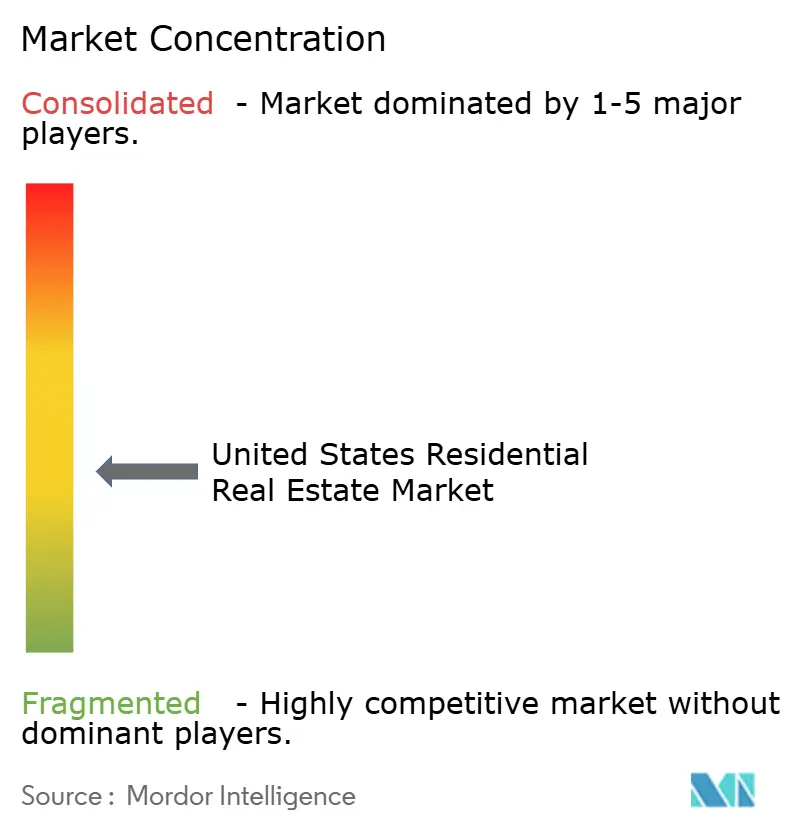
Recent Industry Developments
- April 2025: Rocket Companies finalized its USD 9.4 billion purchase of Mr. Cooper, expanding servicing to USD 2.1 trillion in loan volume
- April 2025: Fortress Investment Group bought The Village at Gainesville, a 639-unit senior community with an 80-person wait-list, signaling expansion in age-restricted rentals.
- December 2024: New Home Co. agreed to acquire Landsea Homes for USD 1.2 billion, supported by USD 650 million in equity from Apollo Global Management, with closing expected in Q3 2025.
- April 2024: CoStar Group completed its USD 1.6 billion acquisition of Matterport, enhancing virtual tour capabilities across listings.
Research Methodology Framework and Report Scope
Market Definitions and Key Coverage
Our study frames the United States residential real estate market as the total dollar value of completed transactions in newly built and existing housing units, single-family homes, apartments, and condominiums sold or rented for private dwelling purposes across all 50 states during a calendar year. Values capture the full property consideration (land and structure) at closing or lease initiation rather than brokerage fees.
Scope exclusions include timeshares, cooperative housing shares, vacation rentals shorter than six months, and any commercial mixed properties that are not counted.
Segmentation Overview
- By Property Type
- Apartments and Condominiums
- Villas and Landed Houses
- By Price Band
- Affordable
- Mid-Market
- Luxury
- By Business Model
- Sales
- Rental
- By Mode of Sale
- Primary (New-Build)
- Secondary (Existing-Home Resale)
- By Region
- Northeast
- Midwest
- Southeast
- West
- Southwest
Detailed Research Methodology and Data Validation
Primary Research
We complemented desk findings with semi-structured interviews and pulse surveys of homebuilders, multifamily operators, title insurers, and state-licensed agents across the Northeast, Sunbelt, Midwest, and Pacific regions. Their ground-level intelligence on deal velocity, incentive use, and net effective pricing helped stress-test secondary data and refine vacancy, absorption, and average-sale-price (ASP) assumptions.
Desk Research
Mordor analysts opened with a sweep of authoritative, non-paywalled sources such as the U.S. Census Bureau's Building Permits Survey, Federal Reserve Economic Data for mortgage costs, HUD's Comprehensive Housing Market Analyses, and National Association of Realtors monthly sales releases. Macro context on household formation and migration patterns was drawn from BEA personal-income tables and Bureau of Labor Statistics employment data. Select insights on capital flows came from D&B Hoovers and Dow Jones Factiva. These sources illustrate market scale, price dynamics, and regulatory backdrops; yet they rarely align on valuation baselines. Therefore, they serve as guardrails, not final answers. The list is indicative, and many additional publications were reviewed to verify trends and numeric consistency.
Market-Sizing & Forecasting
A top-down build converts national housing stock, turnover ratios, and median transaction prices into a gross market pool, which is then cross-checked through selective bottom-up rollups of public builders' closings and sampled ASP × unit volumes. Key model inputs include the annual mover rate, single-family housing starts, 30-year fixed mortgage rate, regional median list-to-close discount, and institutional Build-to-Rent penetration. Forecasts use a multivariate regression where turnover and ASP are driven by disposable income growth, mortgage affordability indices, and housing-start pipelines, with scenario overlays for policy shifts. Gaps in builder rollups are bridged by county deed recordings and trade-association rental surveys.
Data Validation & Update Cycle
Outputs pass three-layer checks: analyst peer review, variance screens versus HUD demand forecasts and NAR sales tallies, and senior-review sign-off. The model refreshes annually, while material shocks, rate spikes, stimulus bills, and disaster declarations trigger interim revisions before report delivery.
Why Our US Residential Real Estate Baseline Commands Reliability
Published estimates often diverge because researchers choose different property scopes, price bases, or refresh cadences.
Key gap drivers include some studies that track only broker revenue, others that roll residential into a broader real estate basket, and many that rely on dated census snapshots without reconciling fast-moving mortgage and migration shifts. Mordor's baseline, anchored in full-value transaction dollars and refreshed each year against live deed and lender feeds, avoids those drifts and provides decision-makers with a steady reference point.
Benchmark comparison
| Market Size | Anonymized source | Primary gap driver |
|---|---|---|
| USD 2.64 Trillion (2025) | Mordor Intelligence | - |
| USD 0.83 Trillion (2024) | Regional Consultancy A | Covers North America aggregate; omits existing-home resale volume and applies constant 2020 ASPs |
| USD 130.02 Billion (2024) | Trade Journal B | Tracks only developer revenue across all property types, excludes rental turnover and secondary sales |
Taken together, the comparison shows that headline gaps stem mainly from scope compression and outdated price anchors. By combining live transaction data with stakeholder validation, Mordor delivers a balanced, transparent baseline that clients can replicate and challenge with confidence.
Key Questions Answered in the Report
What is the current size of the United States residential real estate market?
The market is valued at USD 2.64 trillion in 2025 and is projected to reach USD 3.11 trillion by 2030.
Why are build-to-rent communities expanding so quickly?
Rising mortgage costs and affordability barriers are steering households toward professionally managed single-family rentals, prompting a 307% increase in BTR deliveries between 2019 and 2023.
How are mortgage-rate swings affecting home sales?
Average 30-year rates near 7% create a “lock-in” gap that discourages owners from selling, constraining inventory and shifting demand to rentals and new construction.
Which regions show the fastest growth?
The West records the strongest forecast CAGR at 2.40% through 2030, driven by supply shortages and tech-sector employment, despite climate and insurance challenges.
What role does institutional capital play?
Private-equity firms and REITs—led by Blackstone and Invitation Homes—are accelerating acquisitions, yet their combined holdings still represent about 1% of U.S. single-family housing, suggesting considerable runway for further investment.
Page last updated on:
